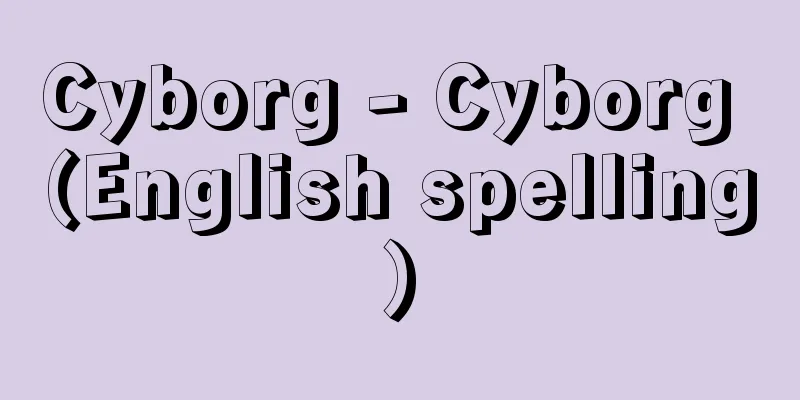Cyborg - Cyborg (English spelling)

|
This refers to a human-machine integration in which humans and machines become one and the machine functions as an autonomous regulatory system without the human being being conscious of it. [Katsumi Shindo] Origin of the CyborgIn their 1960 book , Cyborgs in Space , Americans Manfred E. Clynes (1925- ) and Nathan S. Schellenberg Kline (1916-83) proposed the concept of replacing various parts of the human body with artificial devices, enabling humans to live in outer space. In this book, Clynes named the combination of a living organism and a mechanical device a cybernetic organism, shortened to cyborg, based on the theory of cybernetics, a branch of science that deals with the control and communication systems of both living organisms and mechanical devices, proposed by American mathematician Norbert Wiener in 1948. Initially, cyborgs were conceived as superman cyborgs that could perform functions beyond those of ordinary humans by attaching various devices to humans. However, in reality, research is focused on medical and welfare cyborgs, where artificial devices are attached to human bodies that have become defective due to illness, trauma, aging, etc., to restore normal functions. However, these devices should ideally be integrated with the body's regulatory and control systems to maintain the stability of the body's physiological functions (physiological homeostasis), and it is unreasonable to call a person who wears prosthetic limbs or contact lenses as assistive devices a cyborg. Currently, research is being conducted on moving prosthetic limbs at will and regaining lost eyesight by directly connecting nerves to mechanical devices and sending and retrieving information directly to the brain in the form of electrical signals. If this technology is established, it will be possible to create a cyborg in the true sense of the word. [Katsumi Shindo] Cyborgs in the mediaIn the world of literature and audiovisual media, cyborgs are often taken up as an attractive subject. In Japan, a manga series called "Cyborg 009" (originally written by Shotaro Ishinomori) appeared in 1964 (Showa 39), just four years after the word "cyborg" was coined. This work was later made into animated films in 1966, 1967, and 1980, and was broadcast as a television anime in 1968 and 1979. "Kamen Rider," by the same author, appeared as a serialized manga in 1971 and was also made into a television drama and many sequels were made. In the United States, in 1974, a TV drama "The Six Million Dollar Man" was produced, in which a former astronaut undergoes cyborg surgery and becomes a cyborg spy, and a sequel, "The Bionic Girl," was made, featuring a female cyborg as the protagonist. In 1987, the movie "Robocop" was released, and a sequel was also made. Many of the cyborgs that appear in novels and movies, including these works, tend to feel disgust or inferiority complex about their existence as superhumans made by machines. They worry that they are not human, but a kind of monster. But Herba, the protagonist of The Ship That Sang, written by Anne MacCaffrey (1926- ), in 1960, the year the word cyborg was coined, is different. When she was 16, the young girl Herba's brain was extracted and installed as a control device on a large rocket, and she became a cyborg spaceship. After much worry, she came to accept that she was a cyborg. However, to achieve this, she needed counseling and education from a professional psychologist. In the 1980s, coupled with the development of computers, a number of novels appeared on the theme of a fusion of computers and human nerves that was directly connected to each other, or a world in which such things existed normally; these came to be called cyberpunk. With the rapid evolution of computers that followed, stories were created in which virtual characters unfold in computer-generated virtual spaces. However, for some reason, the characters in this type of work, as typified by the film The Matrix (1999), are rarely called cyborgs, even though they are a combination of living things and mechanical devices. This is probably because, as long as they exist as residents of the cyberworld, they are independent beings, not a fusion of two things. [Katsumi Shindo] "Cyborg" by D.S. Harassy, translated by Sakurai Yasuhisa (1968, Hakuyosha)" ▽ "The Singing Ship" by Anne McCaffrey, translated by Sako Mariko (1984, Tokyo Sogensha)" ▽ "Pessimistic Cyborg: Desire for a Universal Language Machine" by Nishigaki Toru (1994, Seidosha) ▽ "Nagase Yui, Nutopia of the Body: An Archaeology of Robots, Powered Suits, and Cyborgs" by Nagase Yui (1996, Seikyusha) ▽ "Ape, Woman, and Cyborg: Reinventing Nature" by Donna Haraway, translated by Takahashi Saki (2000, Seidosha) [References] | | |Source: Shogakukan Encyclopedia Nipponica About Encyclopedia Nipponica Information | Legend |
|
人間と機械が一体となり、意識することなしに機械が自律的調節系として働く、人間‐機械統合体のこと。 [新藤克己] サイボーグの由来アメリカのマンフレッド・E・クラインズManfred E. Clynes(1925― )とネイザン・S・クラインNathan Schellenberg Kline(1916―83)は1960年に著したCyborgs in Space(宇宙のサイボーグ)のなかで、人間の肉体の各部分を人工機器に置き換えることによって、人間が宇宙空間で生きていけるようにするという概念を提唱した。そのなかでクラインズは、1948年にアメリカの数学者ノーバート・ウィーナーによって提唱された、生物、機械装置の区別なくそれぞれの制御・通信系の問題を扱う科学の一分野であるサイバネティックスの理論に基づいて、生物と機械装置の結合体をサイバネティック・オーガニズムcybernetic organismと名づけ、縮めてサイボーグとよんだ。 当初サイボーグは、人間にさまざまな装置を取り付けることによって、通常の人間以上の働きをさせるスーパーマン・サイボーグとして考えられた。しかし現実には、病気・外傷・加齢などによって欠陥が生じた人体に人工装置を取り付けて、正常な働きを回復させる医療福祉的サイボーグが研究の中心となっている。しかし、これらの装置は、人体の調節・制御システムと一体になって人体の生理機能の安定性を維持すること(生理的ホメオスタシス)が理想であり、補助器具としての義手や義足、あるいはコンタクトレンズをつけた人間をサイボーグとよぶのは無理がある。現在、神経と機械装置を直結し、電気信号のかたちで脳に直接情報を送り込んだり取り出したりすることによって、義手や義足を意のままに動かしたり、失われた視力を取り戻す研究が進められているが、この技術が確立すれば本来の意味におけるサイボーグが誕生することになる。 [新藤克己] メディアに登場するサイボーグ文学や視聴覚メディアの世界において、サイボーグは魅力ある素材としてしばしば取り上げられている。日本では、サイボーグということばができてわずか4年後の1964年(昭和39)に『サイボーグ009』(石ノ森章太郎原作)というシリーズ漫画が登場した。この作品はその後66、67、80年にアニメ映画化され、68年と79年にはテレビアニメとして放送された。同じ作家による『仮面ライダー』は、71年に連載漫画として登場するとともにテレビドラマ化され、続編がたくさん制作された。アメリカでは74年に元宇宙飛行士がサイボーグ手術を受け、サイボーグ・スパイとして活躍するテレビドラマ『600万ドルの男』が制作され、その続編として女性サイボーグを主人公とした『バイオニック・ジェミー』がつくられた。87年には映画『ロボコップ』が公開され、続編もつくられた。これらの作品を含めて、小説や映画に登場するサイボーグの多くには、機械によって超人化された自分という存在に嫌悪感や劣等感を抱く傾向がみられる。彼らは、自分は人間ではなく化物の一種だと悩むのである。しかしサイボーグということばができた1960年にアン・マキャフリーAnne MacCaffrey(1926― )が書いた『歌う船』の主人公ヘルバは違う。少女ヘルバは、16歳のときにその頭脳だけを取り出し、大型ロケットに制御装置として搭載されたサイボーグ宇宙船だが、悩んだすえに自分がサイボーグであることを積極的に受け入れるようになる。ただし、そのためには専門の心理学者によるカウンセリングや教育が必要であった。 1980年代になると、コンピュータの発達とあいまって、コンピュータと人間の神経が直結されて両者が融合した結合体や、そういうものが普通に存在する世界を主題とした小説がいくつも登場し、サイバーパンクとよばれるようになった。その後のコンピュータの急速な進化により、コンピュータによってつくられた仮想空間を舞台に、そこで繰り広げられる仮想(バーチャル)の人物の物語が創作された。しかし映画『マトリックス』(1999)に代表されるこの種の作品の登場人物は、生物と機械装置の結合体であるにもかかわらず、なぜかサイボーグとよばれることはまずない。サイバーワールドの住人として存在するかぎりにおいては、何かと何かの融合体ではなく、一個の独立した存在だからだろう。 [新藤克己] 『D・S・ハラシー著、桜井靖久訳『サイボーグ』(1968・白揚社)』▽『アン・マキャフリー著、酒匂真理子訳『歌う船』(1984・東京創元社)』▽『西垣通著『ペシミスティック・サイボーグ――普遍言語機械への欲望』(1994・青土社)』▽『永瀬唯著『肉体のヌートピア――ロボット・パワードスーツ・サイボーグの考古学』(1996・青弓社)』▽『ダナ・ハラウェイ著、高橋さきの訳『猿と女とサイボーグ――自然の再発明』(2000・青土社)』 [参照項目] | | |出典 小学館 日本大百科全書(ニッポニカ)日本大百科全書(ニッポニカ)について 情報 | 凡例 |
Recommend
Temperature Sensitivity
This refers to the property of crops in which head...
Trumpler's Stars
These are unusually massive stars discovered by R....
Luneville (English spelling)
...However, the simplicity of his style and the r...
Kamiyamada Taiko Dance
...Harvest thanksgiving dances are held at the au...
Learning status achievement survey - gakushu jokyo to tatsu dochosa
...The most representative postwar survey is the ...
Shiraoka [town] - Shiraoka
A former town in Minami Saitama County, eastern Sa...
Busoni
Italian composer and pianist. Both parents were mu...
Corvus frugilegus (English spelling)
… [Yukio Taniguchi]. … *Some of the terminology t...
Scipio the Great - Scipio
Roman general and politician. Born into a distingu...
Yeongpaku Plain - Yeongpaku Heiya
An alluvial plain stretching from southeast of Hae...
Corona - Corona (English spelling)
Coronas include the solar corona, stellar corona,...
Masbate [island] - Masbate
An island located in the northern Visayas in the c...
Shikshim
…The remains of a cluster of Buddhist temples are...
Dānge (English spelling) Śrīpad Amrit Dānge
1899‐1991 Indian communist politician. A supporter...
Wing chord
… [Names of each part of the wing] An airfoil usu...









